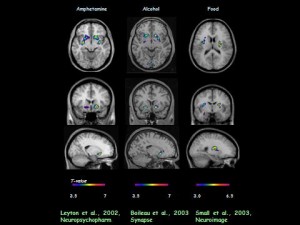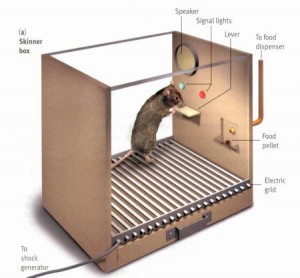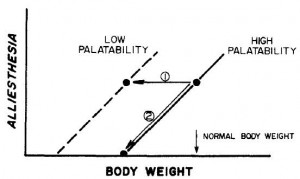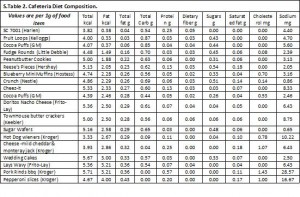Sometime in the late ‘90’s I thought a bland diet would cure obesity. If meals consisted of baked chicken and plain rice, or hard-boiled eggs and oatmeal, for example, then soon people wouldn’t look forward to eating and mealtimes would be unpleasant. Eventually, food intake would revert to being governed properly by hunger as opposed to the rewarding or hedonistic aspects of delicious [junk] foods. Furthermore, food intake might even be less than energy expenditure because the reduced caloric intake would be supplemented with stored energy from fat tissue until a normal body weight was regained (an early version of the set point theory?).
I still think this is true, but completely impractical. Suggesting the removal of tasty junk food is generally considered militaristic and is often countered with loaded [and relatively meaningless] phrases like “everything in moderation.”
which brings me to this hilarious ms: Studies in normal and obese subjects with a monitored food dispensing device (Hashim and Van Itallie, 1965 Annals of the New York Academy of Science)
There are a ton of complicated studies involving lean and obese subjects, given bland or sweet foods while electroencephelograms measure brain electrical activity in attempt to determine if obesity affects a person’s response to or liking of sweets….
this study is way cooler.
The abstract, in its entirety [sic]: 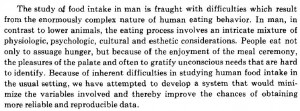
This is possibly one of the best controlled human dietary intervention studies of all time.
In brief, this study used a human-sized Skinner box to measure consumption of a bland yet nutritionally complete food-like liquid substance (“It’s a single cell protein combined with synthetic aminos, vitamins, and minerals. Everything the body needs.” –Dozer, The Matrix). 50% carb, 20% protein, 30% fat (strictly in terms of macronutrients, not too different from the modern Western diet [~60% carb, 15% protein, 25% fat])
Whenever a subject was hungry, they would put the straw in their mouth and press a lever to dispense exactly 7.6 mL of Nutrament. Intake was monitored by a microwave-sized computer, and the only instruction was to feed exclusively from the machine, ad libitum, i.e., with no restrictions whatsoever.
Experiment #1: a lean man, 60 years of age, studied for 16 days. 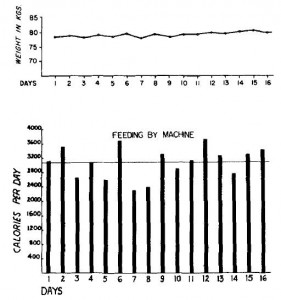
This subject quickly adapted to the diet and was able to maintain body weight for the entire duration of the intervention. Similar results were obtained from another male subject, 20 years of age, studied for 9 days.
Interpretation: 1) the machine works equally well for young and old [lean] subjects, and 2) switching from a normal diet to the bland Nutrament didn’t appreciably affect food intake or energy expenditure because calorie intake and body weight were unchanged.
Here is where it gets interesting. Next they tested a 400-lb [obese] man, 27 years of age. His caloric intake and body weight dropped markedly for 70 days straight despite being encouraged to eat whenever hungry. After 70 days, he was switched to a similarly bland meal-replacement beverage for another 6 months, during which time body weight continued to rapidly decline. “ … the patient never complained of hunger or gastrointestinal discomfort.” 
Body weight (top half), calorie intake (bottom half). Red dot, baseline; orange dot, machine feeding period; green dot, switched to drinking from a cup instead of from the machine; blue dot, feeding from the machine and the cup; purple dot, given a liquid formula to consume at home with instructions to restrict physical activity. The last part of the study was the only time when food intake was restricted, and given the consistent reduction in body weight, adherence was likely 100%.
They switched him to drinking from a cup to determine if there was something about “the bizarre feeding situation,” i.e., feeding exclusively from the machine, which inhibited food intake. Calories increased a little, but not much. NB when he was sent home, they instructed him to restrict physical activity (probably to reduce excess stimulation of hunger). Overall, he lost 200 pounds. Similar results were obtained with a 390-pound woman, 36 years of age, who over the course of 23 days lost 23 pounds. In all of these cases, food intake spontaneously decreased to an extremely low level if the subject was obese.
The authors thought it was important that 1) the liquid was bland, 2) the subjects didn’t know how many calories they were ingesting, and 3) they were no longer eating in a social atmosphere. “In other words, [the subject] is guided principally by subjective hunger.” couldn’t have said it better myself.
Although Hashim’s sample sizes were small, this isn’t an isolated phenomenon. Influence of a monotonous food on body weight regulation in humans (Cabanac and Rabe, 1976 Physiology & Behavior)
These researchers carried out a similar intervention, subjects were provided a bland liquid supplement “Renutril” as their sole source of calories, of which they were instructed to consume ad libitum while avoiding “as much as possible the odor, the sight, and even the thought of any other foods.” Alliesthesia, or the “liking” of sweet foods with a full or empty belly, was also assessed before and after weight loss. These subjects ingested significantly more calories than those in Hashim’s study (> 1000 vs. < 500 kcal) but they still lost a lot of weight (similar bland liquid calories: “Renutril”). 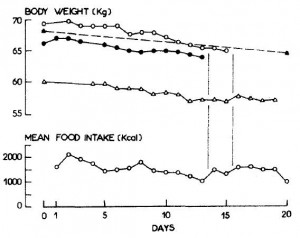
Alliesthesis (see figure below): Normally, a sucrose-sweetened beverage is perceived to be sweeter as sucrose concentration increased, and this is blunted after a 50-gram bolus of glucose is delivered directly into the stomach (via naso-gastric tube) (top left in figure below). IOW, with a belly full of calories, food tastes less delicious (hunger IS the best spice). Similar results were obtained after weight loss with ad lib Renutril (bottom left), but not with a calorically-restricted, flavorful “mixed” diet (top right [pre-weight loss] vs. bottom right [post-weight loss]). 
Interpretation? Caloric restriction-induced weight loss on a flavorful “mixed” diet must induce somewhat of a starvation response (since it tastes good, your “wanting more of it” overpowers the signal from the calories in your belly). Importantly, this is not the case with ad libitum Renutril-induced weight loss; these subjects were honestly not hungry. They weren’t sad or depressed about the new liquid diet; they just simply weren’t hungry.
Apparently, cravings were not a problem in Hashim’s or Cabanac’s studies. It’s a weird paradigm, but I like Cabanac’s final figure:
translation: body weight set point on a bland diet is lower than on a flavorful diet
Furthermore:  sounds like torture!
sounds like torture!
From Hashim we saw that a bland diet could promote the loss of excess fat mass by reducing hunger. Starvation does not ensue because the subjects have excess fat mass (by definition, as this only works in obese people) to supply energy for the body. One important point here is that these effects seem to be dependent on the presence excess fat mass; caloric intake was normal and body weight maintained in lean subjects. The second important point, garnered from Cabanac, is that the diet must be bland to prevent the rebound ravenous hunger experienced by most dieters. Subjects who lost weight by a calorie-restricted mixed diet were not adequately satiated even when they had a belly full of calories (hypocaloric flavorful diet –> impaired alliesthesis). IOW it’s not “calories” because they were reduced in both cases; it is the diet. (yes this is further confirmation that the type of calories matters)
Last but not least, the complete opposite is also true. From a recent [infamous] rodent study: Cafeteria diet is a robust model of human metabolic syndrome with liver and adipose inflammation: comparison to high-fat diet (Sampey et al., 2011 Obesity)
I applaud these researchers for their extremely meticulous and detailed food intake data, which was particularly difficult and labor-intensive because the “cafeteria diet” was employed. The cafeteria diet provides rodents with their usual chow, but also includes a rotating selection of bona fide human junk foods like Fruit Loops, Hostess Blueberry Muffins, Cheez-it crackers, Frito’s, etc., etc. So measuring food intake isn’t as simple as collecting the leftover pellets, they have to really dig around to get all the crumbs, etc., and separate them to know exactly how much of each food was consumed.
A sample menu:
At the end of the day, when all of the hard work is done, we get this neat little table: 
Divide and conquer
Note to nutrition researchers: this is a great way to present food intake data. The only thing missing is one or two more columns stating the primary source of the fat and proteins (could actually get rid of the “Fat kcal” column because it’s redundant).
The cafeteria diet is a wide variety of junk food (a double whammy: variety & junk). And as seen below, the cafeteria diet hijacks food intake homeostasis. On either the low-fat (open squares, “LFD), high-fat (closed squares, “HFD”), or standard chow (open circles, “SC”) diets, rats ate about the same number of calories.
But they go crazy for the cafeteria diet (closed circles, “CAF”). NB the 3 “control” diets (LFD, HFD, & SC) represent a wide variety of macronutrient ratios, and none of them are consumed as much as CAF. That’s because of one simple reason: the cafeteria diet is delicious. A bland diet will promote the loss of excess fat mass (Hashim & Cabanac), and a delicious junk food diet will promote the accumulation of excess fat mass:
Cafeteria rats gained almost twice as much weight as chow, who gained the least amount of weight (probably because standard rodent chow has the least sugar of all the diets). So palatability plays a big role in determining hunger and food intake in humans (Hashim & Cabanac) AND rodents (Sampey). Macronutrient composition is important, as it will determine how the ingested calories are partitioned (see figure e, above). Sugar makes everything taste better; Crisco is gross, but if you add some sugar the resulting ‘icing’ is delicious. disclaimer, I don’t condone the consumption of straight sugar, Crisco, or any combination therein.
Lastly, think about the bland diet / weight loss connection. think it would work? (the difference between obese and lean subjects was quite robust, much more so than anything that has come from an electroencephalogram)… If the patients really didn’t feel hungry, is it such a bad idea? eating delicious food is “rewarding,” but it’s not like they’re being asked to avoid all rewarding activities (e.g., sex).
That’s all for now!
For personalized health consulting services: drlagakos@gmail.com.
Affiliate links: Still looking for a pair of hot blue blockers? TrueDark is offering 10% off HERE and Spectra479 is offering 15% off HERE. Use discount code LAGAKOS for a deal on CarbonShades. If you have no idea what I’m talking about, read this then this.

